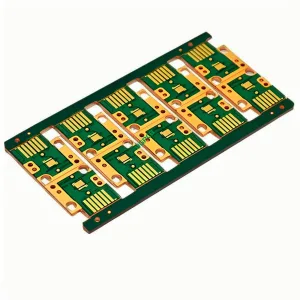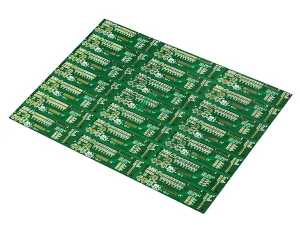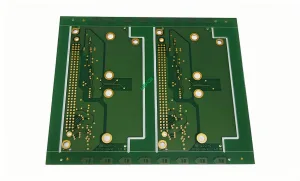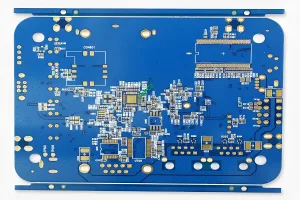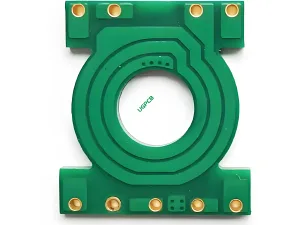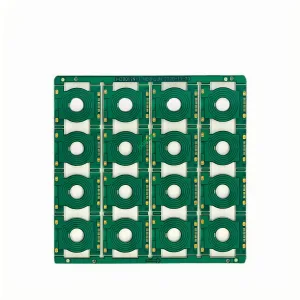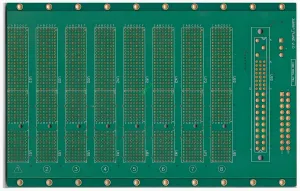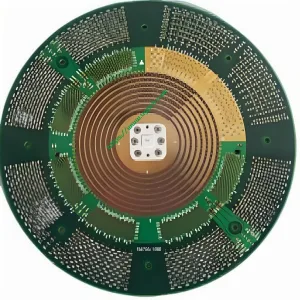Aluminum PCB is a kind of Metal-Based PCB, which has a good heat dissipation function. Generally speaking, the 1 layer aluminum PCB is composed of three layers. circuit layer, dielectric layer, and aluminum base layer; while the structure of 2 layer PCB is more complex, which is composed of the circuit layer, a dielectric layer, aluminum base layer, dielectric layer, and circuit layer. The aluminum PCB board material has high thermal conductivity, which is suitable for drilling, punching, cutting, and other conventional machining methods. The addition of an aluminum PCB base board makes the aluminum PCB have excellent thermal conductivity, and the thermal insulation dielectric layer provides high strength electrical insulation performance. The device with a surface mounted on PCB generates heat, and the heat is transmitted to the aluminum base through the dielectric layer, and the heat is transferred out by the aluminum substrate layer, so as to realize the heat dissipation of the device. However, due to the conductivity of aluminum, it can not realize the performance of inter-layer interconnection, so the application of aluminum circuit board is also limited.
The traditional resin is used to fill the large holes in the existing 2 layer aluminum PCB to realize the interconnection between layers. However, there are many disadvantages: firstly, the traditional resin filling the large holes is easy to produce bubbles, and cracks are easy to occur at high temperature, so the yield is very low; secondly, the thermal conductivity of the traditional epoxy resin is only 0.2W / (m.k), More and more can not meet the heat dissipation requirements of the aluminum substrate, and the heat dissipation coefficient of Aluminum Based PCB manufacturing in this way, the heat dissipation coefficient at hole position and the heat dissipation coefficient between layers are different, which can not meet the quality requirements of products.
Double-sided aluminum PCB is generally composed of the circuit layer, insulation layer, aluminum base layer, insulation layer, and the circuit layer. It is a kind of metal core circuit board with a good heat dissipation function. This kind of PCB board has wiring on both sides, but to use the wires on both sides, it is necessary to have a proper wiring connection between the two layers.
1. PCB circuit layer on a 2 layer aluminum substrate PCB
The circuit layer is copper, which conducts electricity.
2. PCB insulation layer on a 2 layer aluminum core PCB
The insulation layer is made of thermal insulation material, which plays a role in whether the heat generated by LED can be quickly transferred to an aluminum PCB, which depends on the thermal resistance of the thermal insulation material.
3. Double-sided aluminum PCB’s aluminum substrate
The function of the aluminum substrate is to transfer the heat from thermal insulation material to circuit layer again, and another function is to install.
Is the thermal conductivity of aluminum substrate better related to the thickness of the aluminum PCB?
This is not the case. If you want to improve the thermal conductivity of the aluminum substrate PCB, the key is to improve the performance of thermal insulation materials and reduce the thermal resistance of thermal insulation materials. It is not a simple thing to reduce the thermal resistance of insulating materials, which will be affected by the material composition and the manufacturing process.
A pilot hole is a small hole filled or coated with metal on a PCB board, which can be connected with wires on both sides. Because the area of 2 layer aluminum substrate PCB is twice as large as that of 1 layer aluminum substrate PCB, and 2 layer aluminum PCB solves the difficulty of wiring interleaving in single-sided aluminum PCB (it can lead to the other side through holes), so it is more suitable for the circuit with more complex than single-layer aluminum PCB.
Why is aluminium used in circuit boards?
The aluminum PCB stackup consists of three layers: copper foil, insulating layer, and metal aluminum.
Now that there is an insulating layer, can the metal layer use any other material than aluminum? Such as copper PCB, stainless steel, iron board PCB, silicon steel board PCB, etc. In addition to the thermal properties, the thermal expansion coefficient, thermal conductivity, strength, hardness, weight, surface condition, and cost of the metal clad board are also considered.
Considering the cost and technical performance, the aluminum sheet is an ideal choice. The aluminum boards available for selection are 6061, 5052, 1060, etc. Metal PCB can also be made of copper, stainless steel, iron, and silicon steel plates if higher thermal conductivity, mechanical, electrical, and other special properties are required.
Aluminum PCB features
The surface of the al PCB board is mounted with mounting technology (SMT) and has good thermal performance in the circuit design.
Aluminum PCB board can reduce temperature, improve power density and reliability of products, and prolong the life of products.
Aluminum circuit board can reduce volume, hardware, and assembly costs.
Al PCB can replace ceramic substrates for better mechanical endurance.
Differences between aluminum PCB and FR4 PCB board
Do you have any questions about the difference between an aluminum base PCB and FR4 PCB board?
1. Both PCB board and aluminum PCB board are designed according to the requirements of PCB board. At present, the aluminum PCB board in the market is generally single-sided aluminum base plate and part of 2 layer aluminum base plate, a small number of multilayer aluminum PCB. PCB board is a large type, the aluminum circuit board is only a kind of PCB board, it is aluminum core PCB material because it has good thermal conductivity.
Generally speaking, the PCB board is FR-4 PCB board. There is a clear difference between the materials used between the aluminum and PCB boards. The main materials of the aluminum PCB are aluminum board, while the main materials of the PCB board are FR-4. Aluminum substrates PCB are special because of their PP material. Good heat dissipation. It’s also more expensive.
Compared with the PCB board, the performance of the metal core circuit board in terms of heat dissipation is better than that of the PCB board, and its thermal conductivity is also different. In general. Aluminum PCB is a kind of PCB, and the price of aluminum PCB baord is more expensive.
Aluminum PCB
How to make aluminium PCB?
Aluminum PCB manufacturing process.
Cutting – drilling – dry film optical imaging – plate inspection – etching – corrosion inspection – green oil – character – green inspection – tin spraying – aluminum base surface treatment – plate punching – final inspection – packaging – shipment
Detailed explanation of some processes:
1.Cutting
(1) To strengthen incoming material inspection, plates with protective film on the aluminum substrate surface must be used.
(2) No baking board is required after cutting.
(3) Handle with care and pay attention to the protection of the al PCB board surface (protective film).
2.Drilling
(1) The drilling parameters are the same as those of the FR-4 PCB.
(2) Drill holes with copper sheet upward.
3.Dry film
(1) Incoming inspection: the protective film on the aluminum base surface must be inspected before grinding. If it is damaged, it must be firmly pasted with blue glue before pretreatment. After treatment, the plate can be ground only after it is inspected again and qualified.
(2) Grinding plate: only the copper surface shall be treated.
(3) Coating: copper surface and aluminum base surface must be coated. the interval between grinding plate and coating shall be controlled to be less than 1 minute to ensure stable coating temperature.
(4) Clapping: pay attention to clapping accuracy.
(5) Exposure: exposure ruler: residual glue in 7 ~ 9 grids.
(6) Development: pressure: 20 ~ 35psi, speed: 2.0 ~ 2.6m/min, all operators must wear gloves and operate carefully to avoid scratching of protective film and aluminum base surface.
4. FQC inspection
(1) The line surface must check all contents according to MI requirements.
(2) The aluminum base surface shall also be inspected, and the dry film on the aluminum base surface shall be free of film falling and damage.
3, Precautions for Aluminum Based PCB manufacturers
1. Pay attention to the standardization of operation in the production process to prevent loss and waste caused by production operation errors.
2. The surface wear resistance of Aluminum Based PCB is poor. Operators in each process must wear gloves and handle it gently to avoid scratches on the board surface and aluminum based surface.
3. In case of discontinuous production, maintenance shall be strengthened to ensure that the conveying is clean and the water tank is clean, so as to ensure the later operation stability and production speed.
Aluminum PCB is widely used in LED lamps, hybrid integrated circuits, automobiles, office automation, high-power electrical equipment, power supply equipment, and other fields with excellent heat dissipation, good machinability, dimensional stability, and electrical performance. In order to be a well-known PCB manufacturer, UGPCB has been praised by customers for its high-quality aluminum PCB at a reasonable price.
 UGPCB LOGO
UGPCB LOGO


